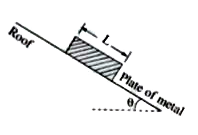Passage - IV:
A perfectly plane house roof makes an angle θ with the horizontal surface. A flat square metal plate of side L rests over the roof. Each day temperature varies between day's high (T1) and day's low (T2). Coefficients of thermal expansions of roof and plate are α1andα2(α2>α1) respectively. Coefficient of kinetic friction between plate and roof is μk. Plate and roof are always in contact and both have same temperature at every instance of day.
Because of difference in coefficients of thermal expansions, each bit of plate is moving relative to the roof, except for points along a certain horizontal line (called stationary line). The stationary line occupies no area, so we assume no force of static friction acting on the plate while the temperature is changing.

When the temperature is raising, then distance of the stationary line from top edge of plate will be
L2(1−tanθμk)
L(1−tanθμk)
2L(1−tanθμk)
23L(1−tanθμk)
The correct Answer is:A
Topper's Solved these Questions
- THERMAL PROPERTIES OF MATTERBOOK - AAKASH SERIESCHAPTER - THERMAL PROPERTIES OF MATTEREXERCISE - ADDITIONAL PRACTICE EXERCISE (LEVEL - II) PRACTICE SHEET (ADVANCED) Matrix Matching Type Questions
2 Videos
- THERMAL PROPERTIES OF MATTERBOOK - AAKASH SERIESCHAPTER - THERMAL PROPERTIES OF MATTEREXERCISE - ADDITIONAL PRACTICE EXERCISE (LEVEL - II) PRACTICE SHEET (ADVANCED) Integer/Subjective Type Questions
2 Videos
- THERMAL PROPERTIES OF MATTERBOOK - AAKASH SERIESCHAPTER - THERMAL PROPERTIES OF MATTEREXERCISE - ADDITIONAL PRACTICE EXERCISE (LEVEL - II) PRACTICE SHEET (ADVANCED) More than One correct answer Type Questions
7 Videos
- SYSTEM OF PARTICLES AND ROTATIONAL MOTIONBOOK - AAKASH SERIESCHAPTER - SYSTEM OF PARTICLES AND ROTATIONAL MOTIONEXERCISE - PRACTICE EXERCISE
99 Videos
- THERMODYNAMICSBOOK - AAKASH SERIESCHAPTER - THERMODYNAMICSEXERCISE - EXERCISE - 3
33 Videos
Similar Questions
There are two rods of length l1 and l2 and coefficient of linear expansions are α1 and α2 respectively.
Find equivalent coefficient of thermal expansion for their combination in series.
View SolutionThe coefficient of linear expansion of crystal in one direction is α1 and that in every direction perpendicular to it is α2. The coefficient of cubical expansion is
View Solution
Knowledge Check
In an isotropic medium, the coefficients of linear expansion of a solid are α1,α2andα3 in three mutually perpendicular directions. The coefficient of volume expansion for the solid is
Aα1−α2+α3Bα1+α2+α33Cα1+α2+α3DNone of theseThe coefficient of linear expansion of P and Q are α1 and α2 respectively. If the coefficient of cubical expansion 'Q' is three times the coefficient of superficial expansion of P, them which of the following is true ?
Aα2=2α1Bα1=2α2Cα2=3α1Dα1=3α2The coefficient of linear expansion of crystal in one direction is α1 and that in every direction perpendicular to it is α2. The coefficient of cubical expansion is
Aα1+α2B2α1+α2Cα1+2α2DNone of these
The coefficient of linear expansion of crystal in one direction is α1 and that in every direction perpendicular to it is α2. The coefficient of cubical expansion is
View SolutionHow dental plate clinges to the roof of the mouth?
View SolutionThere are two rods of length l1 l2 and coefficient of linear expansions are α1 and α2 respectively.
Find equivalent coefficient of thermal expansion for their combination in series.
View SolutionTwo rods having length l1andl2 made of materials with the linear expansion coefficient α1andα2 were soldered together. The equivalent coefficients of linear expansion for the obtained rod
View SolutionA copper and a tungsten plate having a thickness d each are riveted together so that at 0∘C they form a flat bimetallic plate. Find the average radius of the curvature of this plate at temperature T. the coefficient of linear expansion for copper and tungsten are αCuandαW.
View Solution
